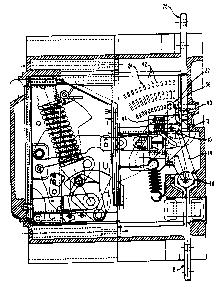Some of the information on this Web page has been provided by external sources. The Government of Canada is not responsible for the accuracy, reliability or currency of the information supplied by external sources. Users wishing to rely upon this information should consult directly with the source of the information. Content provided by external sources is not subject to official languages, privacy and accessibility requirements.
Any discrepancies in the text and image of the Claims and Abstract are due to differing posting times. Text of the Claims and Abstract are posted:
| (12) Patent: | (11) CA 1331035 |
|---|---|
| (21) Application Number: | 1331035 |
| (54) English Title: | ARCING CONTACT ASSEMBLY FOR A CIRCUIT BREAKER |
| (54) French Title: | DISJONCTEUR A COMMUTATION D'ARC |
| Status: | Expired and beyond the Period of Reversal |
| (51) International Patent Classification (IPC): |
|
|---|---|
| (72) Inventors : |
|
| (73) Owners : |
|
| (71) Applicants : |
|
| (74) Agent: | SMART & BIGGAR LP |
| (74) Associate agent: | |
| (45) Issued: | 1994-07-26 |
| (22) Filed Date: | 1989-09-19 |
| Availability of licence: | N/A |
| Dedicated to the Public: | N/A |
| (25) Language of filing: | English |
| Patent Cooperation Treaty (PCT): | No |
|---|
| (30) Application Priority Data: | ||||||
|---|---|---|---|---|---|---|
|
ABSTRACT
An assembly adapted to commutate arcs from between the main
contacts of a circuit breaker to an arcing contact such that a
single arc at the arcing contact can be extinguished and
dispersed within an arc chute. The assembly is adapted to be
pivotally attached to the ends of the main contact carrying arms
and includes are channeling members joined to form a contact
surface An arcing contact can be fixed to the contact surface
such that the arcs from the main contacts are channelled into one
arc at the arcing contact.
Note: Claims are shown in the official language in which they were submitted.
Note: Descriptions are shown in the official language in which they were submitted.

2024-08-01:As part of the Next Generation Patents (NGP) transition, the Canadian Patents Database (CPD) now contains a more detailed Event History, which replicates the Event Log of our new back-office solution.
Please note that "Inactive:" events refers to events no longer in use in our new back-office solution.
For a clearer understanding of the status of the application/patent presented on this page, the site Disclaimer , as well as the definitions for Patent , Event History , Maintenance Fee and Payment History should be consulted.
| Description | Date |
|---|---|
| Inactive: IPC from MCD | 2006-03-11 |
| Inactive: IPC from MCD | 2006-03-11 |
| Time Limit for Reversal Expired | 2003-07-28 |
| Letter Sent | 2002-07-26 |
| Grant by Issuance | 1994-07-26 |
There is no abandonment history.
| Fee Type | Anniversary Year | Due Date | Paid Date |
|---|---|---|---|
| MF (category 1, 3rd anniv.) - standard | 1997-07-28 | 1997-06-17 | |
| MF (category 1, 4th anniv.) - standard | 1998-07-27 | 1998-06-17 | |
| MF (category 1, 5th anniv.) - standard | 1999-07-26 | 1999-06-08 | |
| MF (category 1, 6th anniv.) - standard | 2000-07-26 | 2000-06-14 | |
| MF (category 1, 7th anniv.) - standard | 2001-07-26 | 2001-06-12 |
Note: Records showing the ownership history in alphabetical order.
| Current Owners on Record |
|---|
| SIEMENS AKTIENGESELLSCHAFT |
| Past Owners on Record |
|---|
| CLIFFORD A. BUXTON |
| DAVID A. LEONE |